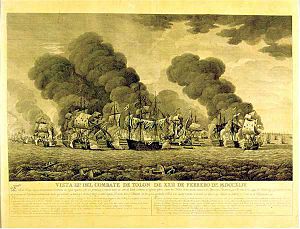
Back Batalla de Toló (1744) Catalan Bitva u Toulonu (1744) Czech Seeschlacht bei Toulon German Batalla de Tolón Spanish Bataille du cap Sicié French Battaglia di Tolone (1744) Italian トゥーロンの海戦 Japanese 툴롱 해전 (1744년) Korean Pertempuran Toulon (1744) Malay Slaget ved Toulon i 1744 NN
| Battle of Toulon | |||||||
|---|---|---|---|---|---|---|---|
| Part of the War of the Austrian Succession | |||||||
 A Spanish illustration of the battle, Naval Museum of Madrid | |||||||
| |||||||
| Belligerents | |||||||
|
|
| ||||||
| Commanders and leaders | |||||||
|
|
| ||||||
| Strength | |||||||
|
27 ships of the line 3 frigates 3 smaller warships |
30 ships of the line 3 frigates 6 smaller warships | ||||||
| Casualties and losses | |||||||
|
149 killed, 467 wounded 3 ships damaged, 1 scuttled |
133 killed, 223 wounded, 17 captured [2] 5 ships damaged, 1 fireship sunk [2] | ||||||
The Battle of Toulon, also known as the Battle of Cape Sicié, took place between 21 and 22 February 1744 NS[a] near the French Mediterranean port of Toulon. Although France was not yet at war with the United Kingdom of Great Britain, ships from their Levant Fleet sailed out to support a Spanish fleet, which was attempting to break through a two-year-old British naval blockade.
The initial engagement on 21 February was largely indecisive and the British continued their pursuit until midday on 22nd before their commander, Admiral Thomas Mathews, called off the chase. With several of his ships in need of repair, he withdrew to Menorca, which meant the British Royal Navy temporarily lost control of the waters around Italy and allowed the Spanish to take the offensive against Savoy.[3]
In his report, Mathews blamed his subordinate Richard Lestock for the failure and the issue was hotly debated in Parliament. At the subsequent court-martial, Mathews was held responsible and dismissed from the navy in June 1747, while Lestock's political connections meant he was cleared of all charges.[4] Another seven captains were removed from command for failing to engage the enemy and the investigation led to changes that required individual captains to be far more aggressive.
France declared war on Britain shortly after the battle but it led to recriminations with the Spanish, who suffered most of the casualties and complained of a lack of support from the French fleet during the battle. The French admiral, Claude Bruyère, was removed from command while the resulting ill-feeling limited further co-operation between the two sides.[5] The Spanish commander Juan José Navarro and his ships spent the rest of the war blockaded in Cartagena, Spain by Mathews' successor William Rowley.
- ^ Wilson & Callo 2004, p. 268.
- ^ a b Allen 1842, pp. 327, 329.
- ^ Dull 2009, p. 52.
- ^ Baugh 2004.
- ^ Anderson 1995, pp. 138–139.
Cite error: There are <ref group=lower-alpha> tags or {{efn}} templates on this page, but the references will not show without a {{reflist|group=lower-alpha}} template or {{notelist}} template (see the help page).
© MMXXIII Rich X Search. We shall prevail. All rights reserved. Rich X Search